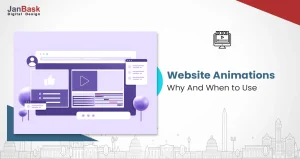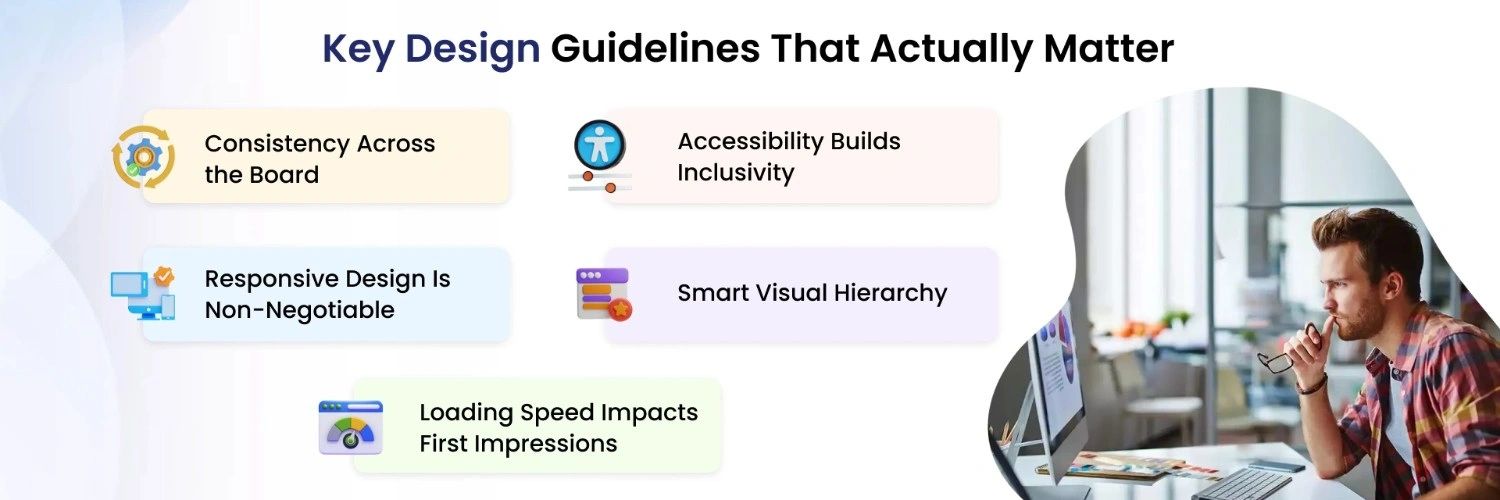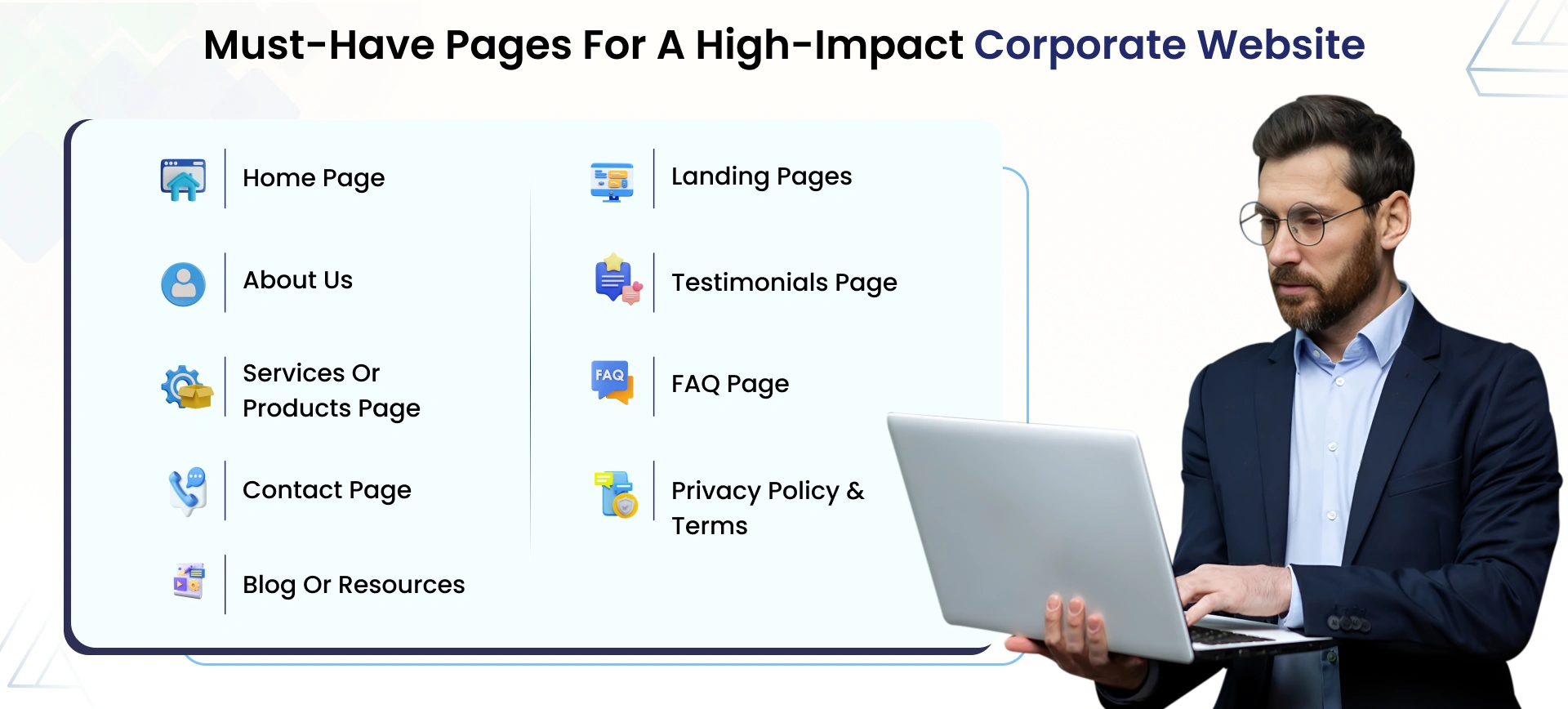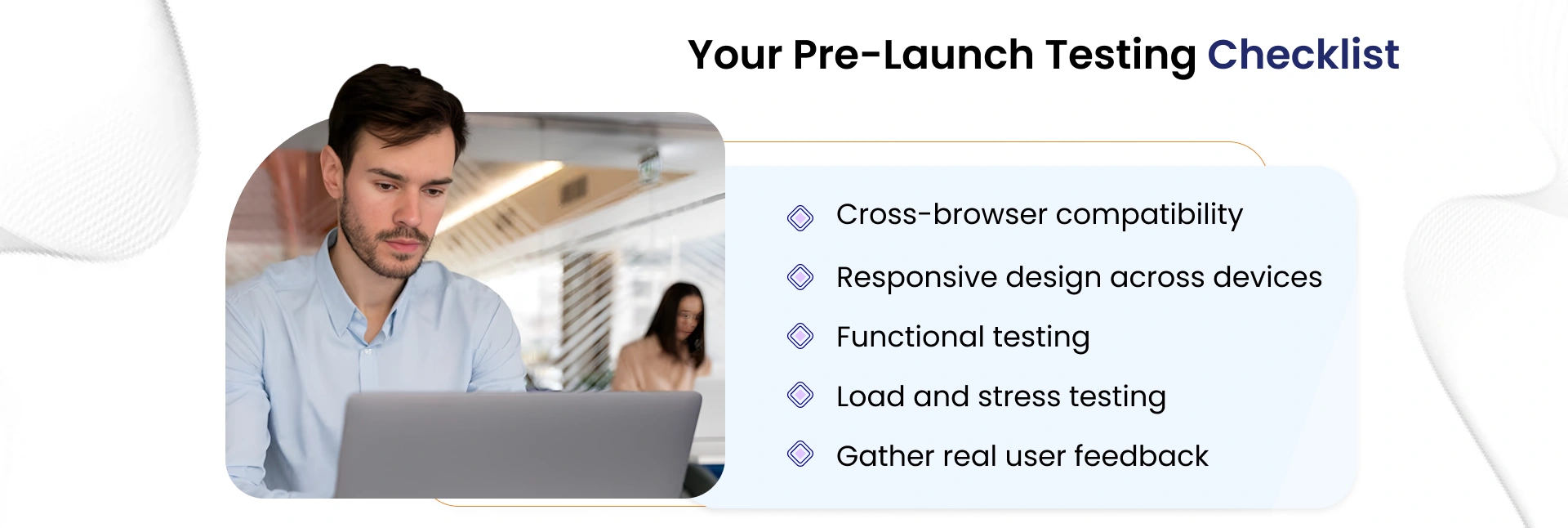
Most corporate websites look the part with a polished logo, clean layout, slick menus but that’s often where the effort stops. Look closer, and many of them feel soulless, like they could belong to any business in any industry. The truth? If your website doesn’t sound like you or reflect how you think and operate, it’s quietly hurting your brand. A corporate site isn’t just a virtual business card; it’s a working asset, and it should be pulling its weight.
So, if you’re wondering how to design a corporate website that truly represents your business, it starts with shifting your mindset. This isn't about fancy visuals or stuffing keywords into empty pages. It’s about building something strategic, something that speaks clearly to your audience, supports your goals, and earns trust in seconds. In this blog, we’ll break down the process step by step — not with buzzwords, but with a practical approach to help you design a site that’s modern, meaningful, and made to perform.
Designing a corporate website goes far beyond simply choosing a template and filling it with content. It requires careful planning and thoughtful strategy to ensure every element—from layout to functionality—aligns perfectly with your business objectives. A successful corporate website not only reflects your brand’s identity but also delivers a smooth, intuitive experience that keeps visitors engaged. By following a clear, step-by-step approach, you can create a professional and effective website that not only attracts attention but also drives meaningful engagement and boosts conversions.
Before you even start thinking about layouts or color schemes, take a step back. The first and most overlooked step in designing a corporate website is defining why you're building it in the first place. Clarity at this stage ensures every design, content, and technical decision serves a specific business purpose. What You Should Focus On:

Are you planning to use your site to generate high-quality leads, position your brand as an industry leader, offer support, or drive direct sales? Your answer will shape how you create your corporate website structure and messaging.
Who’s coming to your site, and what do they expect to find? Know their role (B2B or B2C), their intent (research or buying), and what might influence their trust. Designing for everyone means connecting with no one.
In a sea of corporate websites, what makes yours worth a second look? Be clear about your value proposition. This will help you build a corporate website that feels credible, confident, and consistent with your brand.
Don’t just create a corporate website and hope it performs. Define what performance means—whether that’s lead submissions, engagement time, newsletter sign-ups, or something else.
By clearly defining the purpose upfront, you set the stage for a smarter and more effective corporate website design process that reflects both user needs and your business goals.
Once your goals are defined, the next major step in how to design a corporate website is selecting the platform that will power it. This decision shapes the functionality, flexibility, and growth potential of your site, so it's not something to take lightly.

Ideal for businesses that need full control, flexibility, and access to thousands of plugins. WordPress is a top choice when designing a corporate website that’s content-heavy or requires ongoing updates and SEO optimization.
A beginner-friendly drag-and-drop builder that works well for small to medium businesses. It’s quick to launch but may have limitations when scaling a corporate website with advanced needs.
Known for sleek design templates and ease of use. A good option for brands focused on visuals, though less suited for complex backend features or integration-heavy setups.
Designed for e-commerce, this platform is perfect for companies looking to integrate online product sales into their corporate website with minimal hassle.
For businesses with unique requirements, building from scratch allows you to design a corporate website that’s truly aligned with your branding, security, and performance goals. It requires a bigger investment but offers full freedom and scalability.
Technical Capabilities – If your team lacks development experience, platforms like Wix or Squarespace are more manageable. If you're working with developers or an agency, WordPress or custom-built options offer more control.
Budget – Don’t just consider the upfront cost. Account for expenses related to hosting, plugins, themes, developers, and ongoing maintenance when you create your corporate website.
Scalability – The platform should support future business growth—whether that's adding new services, integrating third-party tools, or improving site performance as traffic increases.
Choosing the right platform lays a solid foundation when you're looking to build a corporate website that performs well, evolves with your business, and delivers a great user experience.
Design isn’t just about how your website looks—it’s about how it works for your audience. When designing a corporate website, the priority should always be usability, not decoration. A clean, consistent, and functional design can increase trust, guide actions, and improve the overall experience.
Here’s how to design a corporate website that’s aligned with your visitors' expectations and behaviors:

Use a consistent layout, font style, button design, and color palette across every page. This reinforces brand credibility and makes your corporate website design feel cohesive rather than chaotic.
More than half of users browse on mobile. If your layout breaks or loads poorly on certain devices, you’re instantly losing credibility. When you create a corporate website, make sure it's responsive across desktops, tablets, and smartphones.
A truly professional corporate site should be usable by everyone—including people with visual, auditory, or motor impairments. Focus on contrast ratios, readable fonts, alt text for images, and keyboard navigation.
Guide your visitor’s eyes to what matters. Whether it’s a service page, a CTA button, or a headline, use size, contrast, and spacing to lead attention logically through your content. This is a core skill when learning how to design a corporate website that converts.
Speed affects bounce rates and user satisfaction. Optimize image sizes, reduce unnecessary scripts, and consider lazy loading for large media. A fast site isn’t just better for users—it helps with SEO too.
When you build a corporate website that feels intuitive and trustworthy, users are far more likely to stay, explore, and take action. And that’s where design truly pays off—not in looks alone, but in results.
Your website isn’t just a digital placeholder—it’s your company’s voice online. And that voice speaks through content. Whether you're planning to build a corporate website from scratch or redesign an existing one, your content strategy should do more than fill space—it should create trust, interest, and action.

The moment someone lands on your site, they should understand who you are and what you offer. When you create a corporate website, avoid jargon and focus on clarity. What do you solve, and why should anyone choose you?
When you think about how to design a corporate website, don’t separate content from SEO. They go hand in hand. Use your keywords (like “corporate website design” or “create corporate website”) thoughtfully in headings, meta tags, and content—but never at the expense of readability.
Avoid robotic or overly formal language. The best content sounds like a real person from your brand is having a conversation with the reader. Match your tone with your audience—whether that’s professional, friendly, innovative, or conservative.
Walls of text drive users away. Support your message with strong visuals—videos that explain, infographics that summarize, and photos that add context. Multimedia plays a big role when you're designing a corporate website that feels modern and engaging.
Stale content signals a neglected business. Maintain a habit of updating blogs, case studies, and product/service pages. This not only improves SEO but also shows users that your company is active and growing.
When you design a corporate website that combines strong messaging with meaningful, well-placed content, you’re not just filling pages—you’re guiding your audience toward trust, clarity, and conversion.
When you build a corporate website, it's not just about having a homepage and calling it a day. Each page should be designed with intention—serving a role in either informing, engaging, or converting your audience. The structure and clarity of these core pages play a critical role in how your business is perceived.
Every successful corporate website is built on a foundation of essential pages that inform, engage, and convert visitors. These pages ensure your brand message is clear, your value is understood, and your site earns trust at every step.

Think of this as your website’s front lobby. It should clearly communicate who you are, what you offer, and why it matters. When designing a corporate website, the homepage should invite exploration, not confusion.
This is where you build emotional connection. Share your company’s journey, vision, leadership, and culture. People want to know the faces and values behind the brand when they visit a corporate website.
Here’s where you demonstrate your value. Go beyond listing services—highlight outcomes, benefits, and what makes your offerings different. If you're trying to create a corporate website that drives conversions, this page must be easy to scan yet persuasive.
Make it simple for users to connect. Include multiple options—forms, email, phone, social links, or even a map if relevant. A well-built contact page signals reliability and openness.
This section allows you to educate, inform, and support your audience. It also helps with SEO and positions your company as a thought leader. Don’t overlook it when planning how to design a corporate website with long-term value.
These supporting pages go beyond the basics to enhance user trust, answer key questions, and show your brand’s credibility—helping visitors feel more confident in taking the next step.
Landing pages are focused, campaign-specific pages designed to drive actions like sign-ups or downloads. With persuasive content and clear calls to action, they help capture leads and support marketing goals.
Social proof is powerful. Real customer feedback builds credibility and can tip the balance in your favor, especially for first-time visitors.
Answering common questions not only reduces the burden on your support team—it also helps visitors feel informed and understood.
These aren’t just legal requirements; they signal professionalism. Especially in sectors where trust is critical, these pages assure visitors that you take data and compliance seriously.
When you create a corporate website with all these pages intentionally planned and clearly written, you're not just ticking boxes—you’re building trust and guiding users along their journey.
Even the most beautifully designed corporate website won’t perform if it’s slow or buried in search results. That’s why both SEO and performance should be built into your process—not added later. If you’re learning how to design a corporate website that brings in traffic and converts, this step can’t be skipped.
Fast, reliable websites keep visitors active and reduce bounce rates. These performance tactics focus on speed, responsiveness, and stability—crucial for delivering a smooth user experience that encourages deeper engagement.

Every extra second of load time increases the risk of visitors leaving. Compress images, minimize CSS and JavaScript, and leverage caching. When you build a corporate website, speed should be a top priority from day one.
Your corporate audience is likely browsing on phones just as much as desktops. Ensure responsive design that adapts to every screen size without breaking layout or readability.
Security is non-negotiable—especially for contact forms or any data collection. HTTPS not only protects your users but is also a ranking signal for search engines.
Strong SEO ensures your corporate website gets found by the right audience. These strategies improve search rankings, drive consistent traffic, and position your brand as a credible industry presence.

Start with identifying high-intent keywords related to your business. Naturally integrate these terms—such as “designing a corporate website” or “how to create a corporate website”—into content, headings, and metadata without overstuffing.
Each page should have a unique and relevant title tag and meta description. These impact how your pages appear in search results and influence click-through rates.
Don’t leave images unnamed. Use descriptive alt text to improve accessibility and help search engines understand visual content.
Guide users to related information through logical, strategic internal links. This improves both user experience and site structure for search engines.
Make SEO and performance optimization an ongoing habit. Regular audits help you stay ahead of technical issues, identify content gaps, and ensure your site remains competitive.
When you create a corporate website with SEO and performance in mind, you're not just building a digital space—you’re building a growth engine.
You’ve put in the work to design and build your corporate website, but before you hit “publish,” it’s time for quality control. Testing isn’t just a technical step—it’s about ensuring the experience you’re offering is reliable, consistent, and ready for real users.
A well-executed testing phase can prevent user frustration, missed conversions, and brand credibility issues after launch.

Your site should look and function properly across Chrome, Safari, Firefox, Edge, and others. Inconsistencies in layout or behavior can damage user trust.
Test the website on multiple screen sizes—from mobile phones to large monitors. When you create a corporate website, the experience must be seamless everywhere.
Check all forms, CTA buttons, login modules, dropdowns, and interactive elements. Anything clickable should behave exactly as intended.
Simulate heavy traffic to ensure your site doesn’t slow down or crash. This is essential when you build a corporate website expected to handle high volumes—like for product launches or campaigns.
Bring in stakeholders, internal teams, or even a few users from your target audience to explore the site. Their feedback often reveals usability issues that technical testing alone can miss.
Launching without proper testing is like releasing a product without inspection. If you're serious about learning how to design a corporate website that builds credibility and converts, testing must be treated as a final, strategic milestone—not an afterthought.
Your job doesn’t end after launch in fact, that’s where the long-term impact begins. A successful approach to designing a corporate website includes planning for updates, security, and performance even after it goes live.
An outdated or neglected site can erode trust and hurt visibility. Ongoing maintenance ensures your corporate website continues to support business goals, deliver value, and stay secure.

Keep adding new blog posts, case studies, press releases, or product updates. Fresh content supports SEO and shows your audience that your business is active and evolving. This is especially important if you're learning how to create a corporate website that builds long-term authority.
Protect your site from vulnerabilities by updating themes, plugins, and core software regularly. Use malware scanners and set up alerts for unusual activity.
Use tools like Google Analytics and performance dashboards to track what users are doing on your site. These insights help you identify what’s working and where to improve. If you build a corporate website, this step ensures you're not making decisions in the dark.
Schedule automated backups and keep offsite copies. If anything goes wrong technical issues, hacks, or accidental deletions you’ll be able to restore your site without major disruption.
Regular maintenance isn’t just technical housekeeping, it’s part of what makes a well-designed corporate website perform and evolve over time. It reflects professionalism, builds trust, and ensures your site stays aligned with your business’s changing needs.
When it comes to website design, crafting a corporate site is more than just making it look good—it’s a strategic process aimed at creating a digital platform that reflects your brand, connects with your audience, and drives your business goals forward. From initial planning to final launch and ongoing updates, every stage matters in building a website that attracts visitors and converts them into loyal customers.
At Janbask Digital Design, we understand the importance of this journey. Our team works closely with you to translate your vision into a dynamic, effective online presence. Whether you’re exploring how to design a corporate website from the ground up or looking to improve and modernize your current site, we ensure every design and functionality choice aligns with your business objectives.
With expertise in responsive layouts, user experience, and technical performance, we focus on building corporate websites that don’t just look great but deliver measurable results. Partner with JanBask Digital Design to create a corporate website that meets your needs today and adapts seamlessly to tomorrow’s challenges.
Start Creating a High-Impact Corporate Website Today!

J
Very informative and practical. This blog gave me clear insights into what a corporate website really needs—especially the part about building trust with clean design.